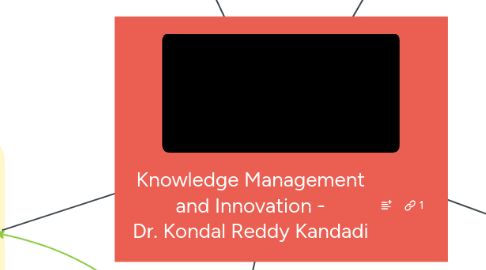
1. Three key components of knowledge management infrastructure
1.1. Culture (People)
1.1.1. To get your organizational culture right
1.1.1.1. Innovation is:
1.1.1.1.1. How do you solve problems in new ways
1.1.1.1.2. How do you do things in new ways
1.1.1.1.3. Invention of new products
1.1.2. Encouraging people to develop informal networks to develop those informal knowledge sharing attitudes
1.1.2.1. Innovations don't happen in meetings, they happen mostly through informal knowledge sharing
1.1.2.1.1. Organizations need to have the right culture
1.2. Process
1.2.1. Knowledge Management is the acknowledgment and appreciation of people contributing / sharing knowledge with others, and coming up with new ways of doing things
1.2.1.1. Learn from success and failure
1.3. Infrastructure
1.3.1. Computer technology structures are tools, not decision makers
1.3.2. Water coolers/coffees
1.3.2.1. Office spaces are very important
1.3.2.1.1. People from different areas meet and talk
1.3.3. Meetings are quality control systems not idea generation systems
2. Solution
2.1. Institutions/Companies need to produce new products at a rapid pace
2.2. This requires knowledge creation on a continual basis
2.3. The markets, innovation and the requirements of knowledge creation have changed
2.3.1. We need knowledge creation at rapid pace, organizing the human knowledge in a systematic process to produce products
3. The problem today
3.1. A single individual cannot produce all of the aspects, it requires collaboration:
3.1.1. It requires knowledge creation
3.1.2. It requires sharing that knowledge with other people/organizations
3.1.3. Applying it to innovate
3.1.4. Organizations need to manage knowledge in a formal/systematic way
3.2. Obsolescent
3.2.1. The obsolescent rate for technology products is about 5% per month
3.2.2. Products change very fast on the market
3.2.2.1. After 1-2 years a product is already out of date
4. One of the first and greatest human innovations is the wheel
4.1. It requires creation of knowledge
4.2. It requires application of that knowledge to make a wheel
4.2.1. Wheels didn't exist in nature
4.2.2. Somebody had to think about the concept and innovate it
4.2.3. That happened about six thousand years ago
5. Innovations of today
5.1. Growing at rapid pace
5.2. One of the greatest human innovations now
5.2.1. The International Space Station
5.3. The way we manage knowledge, the way we innovate one thing won't change:
5.3.1. People
